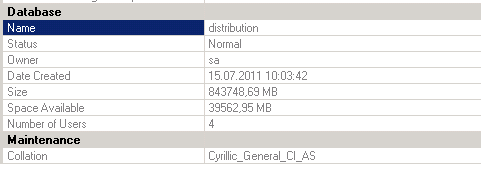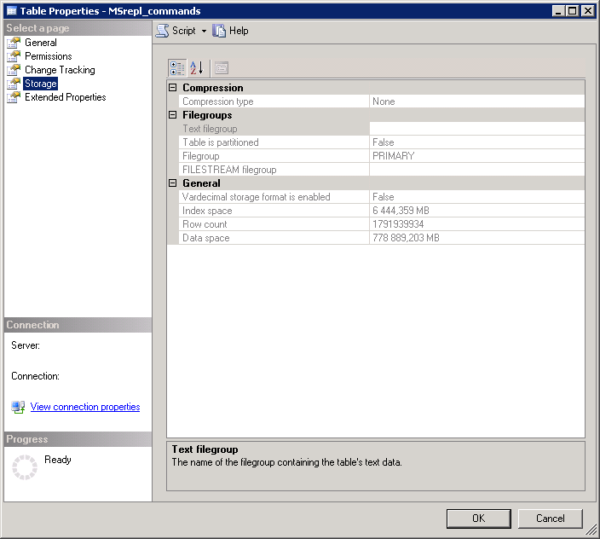REQUEST COMPLIMENTARY SQLS*PLUS LICENCE
Large database size Distribution MS SQL Server
Sometimes you have to face the situation when in Microsoft SQL Server with the configured replication, the database distribution starts to grow. There is nothing wrong with the fact that the database starts growing after the replication task is created.
The distribution database stores metadata and log data for all types of replication as well as transactions for transaction replication. However, there is a few weeks after the replication jobs have been created, the database continues to grow this alarm.
It is likely that a database cleanup job is not being performed or is being performed incorrectly. When replication is created, the job is created: Distribution clean up: distribution. In this job, the stored procedure: dbo.sp_MSdistribution_cleanup is started by schedule.
This stored procedure cleans up the distribution database.
To find out the reasons, you should first check:
1. Whether a cleanup job has been created for the distribution database. bbo.sp_MSdistribution_cleanup.
2. Is this task enabled
3. Check the task execution log for errors, one of the frequent errors is the situation when the employee’s account from under which the task is being executed is blocked or has insufficient rights to the distribution database.
4. The schedule of starting the cleanup task is not set or is missing
If there are no problems in the task, it is worth checking what result the command to run in the task returns.
To do this, create a new query (New Query) and run the script:
USE [distribution]
GO
EXEC dbo.sp_MSdistribution_cleanup @min_distretention = 0, @max_distretention = 72
Where, 72 is the retention time of metadata and replication log data. Normally 72 hours is enough, but you may have your own thoughts on this.
If the distribution database hasn’t been cleaned up for a long time, then waiting for the result of this command can take several hours. This depends on the total size of the database, the time that has elapsed since the last cleanup and the server performance.
In particularly severe cases, such as this one:

Removing outdated records can take days or even weeks, not just hours.
It is a matter of a strongly sprawling table MSrepl_commands and MSrepl_transactions. So, on the example below, the number of records is almost 1.8 billion.

In this situation, to speed up the cleaning of the two most extensive tables, you can manually start the table cleaning by deleting most of the data using the command:
USE distribution
GO
DECLARE @rowcountCom int = 1000000
DECLARE @rowcountTr int = 10000
DELETE TOP(@rowcountCom) MSrepl_commands WITH (PAGLOCK)
FROM MSrepl_commands
WITH (INDEX(ucMSrepl_commands))
DELETE TOP(@rowcountTr) MSrepl_transactions WITH (PAGLOCK)
FROM MSrepl_transactions
WITH (INDEX(ucMSrepl_transactions))
the value for @rowcountCom and @rowcountTr specify no more than 90% of the records you have in these tables.
Once the tables have been cleared of obsolete data, you can perform the final cleanup using the command:
EXEC dbo.sp_MSdistribution_cleanup @min_distretention = 0, @max_distretention = 72
MORE NEWS
PreambleNoSql is not a replacement for SQL databases but is a valid alternative for many situations where standard SQL is not the best approach for...
PreambleMongoDB Conditional operators specify a condition to which the value of the document field shall correspond.Comparison Query Operators $eq...
5 Database management trends impacting database administrationIn the realm of database management systems, moreover half (52%) of your competitors feel...
The data type is defined as the type of data that any column or variable can store in MS SQL Server. What is the data type? When you create any table or...
PreambleMS SQL Server is a client-server architecture. MS SQL Server process starts with the client application sending a query.SQL Server accepts,...
First the basics: what is the master/slave?One database server (“master”) responds and can do anything. A lot of other database servers store copies of all...
PreambleAtom Hopper (based on Apache Abdera) for those who may not know is an open-source project sponsored by Rackspace. Today we will figure out how to...
PreambleMongoDB recently introduced its new aggregation structure. This structure provides a simpler solution for calculating aggregated values rather...
FlexibilityOne of the most advertised features of MongoDB is its flexibility. Flexibility, however, is a double-edged sword. More flexibility means more...
PreambleSQLShell is a cross-platform command-line tool for SQL, similar to psql for PostgreSQL or MySQL command-line tool for MySQL.Why use it?If you...
PreambleWriting an application on top of the framework on top of the driver on top of the database is a bit like a game on the phone: you say “insert...
PreambleOracle Coherence is a distributed cache that is functionally comparable with Memcached. In addition to the basic function of the API cache, it...
PreambleIBM pureXML, a proprietary XML database built on a relational mechanism (designed for puns) that offers both relational ( SQL / XML ) and...
What is PostgreSQL array? In PostgreSQL we can define a column as an array of valid data types. The data type can be built-in, custom or enumerated....
PreambleIf you are a Linux sysadmin or developer, there comes a time when you need to manage an Oracle database that can work in your environment.In this...
PreambleStarting with Microsoft SQL Server 2008, by default, the group of local administrators is no longer added to SQL Server administrators during the...















